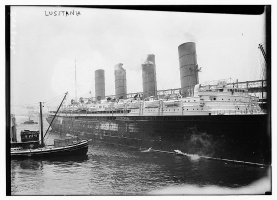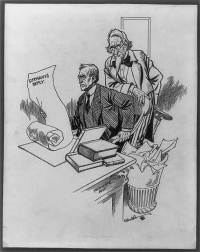Background and Rationale↑
The Sussex Pledge was seen as an attempt by the Imperial German government to appease the United States to prevent a rupture in diplomatic relations as Germany pursued unrestricted submarine warfare. The pledge got its name from the steamer S.S. Sussex built in 1896 used for services between the British Isles and France during World War I and sunk by the Germans in 1916.
First, a German submarine sunk the British passenger ship Falaba in March 1915, followed by the sinking of the famous Lusitania in May 1915 that killed 128 Americans. The British passenger ship S.S. Arabic was attacked and torpedoed only three months later by yet another German submarine near the Irish coast, killing forty. After this incident concern that the President Woodrow Wilson (1856-1924) might sever relations with Imperial Germany along with a desire to tarnish Britain in world opinion as the only violator of neutral rights influenced the German decision to issue the Arabic Pledge. Despite its anger over the amount of financial aid and economic support going to the Allied side, the German government issued the Arabic Pledge on 18 September 1915. Germany promised not to sink passenger ships without warning and to give civilians thirty minutes to leave any ship.
The Sinking of the S.S. Sussex↑
This promise was broken on 24 March 1916 when a German submarine torpedoed the ferry S.S. Sussex which sustained heavy damage, killing fifty and injuring hundreds, including three Americans. The ferry crossed from Folkestone in south-east England to Dieppe in France and was towed to the port of Boulonge-sur-Mar, France. At first the German government denied the torpedoing of the ferry but later admitted that the German submarine, UB-29, mistakenly believed it to be a minelayer. The Marine Nationale at Le Havre repaired the steamer and sold the vessel after the war to Greece where she was scrapped in 1924.
The Sussex incident infuriated President Woodrow Wilson further, who “considered the sacred and indisputable rules of international law and the universally recognized dictates of humanity.”[1] If Imperial Germany would not immediately stop its unrestricted submarine warfare the government of the United States would be “forced to the conclusion that there is but one course it can pursue and otherwise would break off diplomatic relations.” Wilson in part based his decision on the fact that the United States had signed the “Declaration of Rights of Neutral Nations” in 1909, an international code of maritime laws which addressed blockades, convoys, contrabands and non-neutral service in times of war. He expected that the other signees from the warring nations would respect this declaration as well.
The Sussex Pledge and Its Aftermath↑
Chancellor Theobald von Bethmann Hollweg (1856-1921) issued the Sussex Pledge on 4 May 1916. Germany promised to no longer attack any passenger ships, expanding the promise made in the Arabic Pledge. Merchant vessels would only be sunk if war material was aboard but only after all passengers, including the crew, had left the ship. This policy of appeasing the United States aided the German war effort. German submarines effectively sunk large amounts of purely military shipping in the following six months and successfully avoided any showdown with the United States until it resumed unconditional submarine warfare in January 1917.
Simone De Santiago Ramos, University of North Texas
Section Editor: Lon Strauss
Notes
- ↑ Wilson, Woodrow: President Wilson’s Addresses; The Submarine Question, Hamburg 2012, p. 176.
Selected Bibliography
- Bridgland, Tony: Outrage at sea. Naval atrocities of the First World War, Barnsley 2002: Leo Cooper.
- Doenecke, Justus D.: Nothing less than war. A new history of America's entry into World War I, Lexington 2010: University Press of Kentucky.
- Hill, David Jayne: The correspondence regarding the S. S. Sussex, in: The American Journal of International Law 10/3, July 1, 1916, pp. 556-560, doi:10.2307/2187026.
- Link, Arthur S.: Wilson. Confusion and crises 1915-1916, Princeton 1964: Princeton University Press.
- Mancini, Amanda M.: Neutral in spirit? an analysis of Woodrow Wilson's policies and the United States' involvement in World War I, in: International Social Science Review 72/3/4, 1997, pp. 136-145.
- Stark, Matthew J.: Wilson and the United States entry into the Great War, in: OAH Magazine of History 17/1, October 1, 2002, pp. 40-47.










